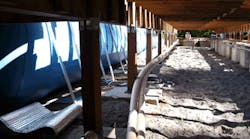Latest from Hydronics
Sponsored
CAMAS, WASHINGTON — “For me, I love the scalability of these solar thermal systems,” said Bob Doyle of Blairco Solar, a new division of Blairco Heating & Cooling. “If you put in a two-panel system, a pump station and a tank, it’s not as if you bought a small car and all of a sudden it won’t fit your larger family. You can add on to it, and do different things to it.”
Doyle is talking about a recent solar application that began with the customer hoping for a cheaper way to heat his pool, and expanded into a combination domestic hot water/radiant heating system — but the flexibility of the technology has been part of its appeal since he first became interested in hydronic heating.
Doyle began his work in hydronics after a 27-year career in the airline industry. “Six years ago,” Doyle said, “I built a home for my parents choosing hydronic heating because of its efficiency, even temperatures and most importantly its cleanliness.” Doyle’s father, a retired Chicago firefighter, had some breathing difficulties, so a ductless system that wouldn’t be blowing dust or other particulates around was definitely the way to go.
After that, Doyle went on to found his own solar thermal companies, finally partnering up with Blairco as the head of the Vancouver-based company’s solar division. Doyle himself remains headquartered in Camas, about 20 minutes from Portland, Ore., but on the Washington side of the river.
And before anyone starts making jokes about solar power in the cloudy Pacific Northwest making about as much sense as hydroelectric in the Sahara, Doyle thinks they should get their facts straight.
“On the wet side of the Cascades, the Western sides, which is where our operating area is, we get 25% more sun than Germany as a whole,” Doyle said. “Germany has led the world in solar installs. Another way to look at it is we get 75% of the sun LAX gets.” During the time of our interview, mid-afternoon in early October, his own solar collectors were hitting above 140 degrees.
Doyle was called in to the job the way many solar installers are — after a homeowner finally got one too many high heating bills. In this particular case, the main reason for those high bills was an inefficient propane-powered pool heating system.
“I’m on the proven solar installer list with the local utility,” Doyle said. “There’s only a few other names on there and apparently they’d gotten bids from other contractors. But I think they found my bid not only attractive in a monetary sense, but also from the standpoint of the system design and components.”
What Doyle was able to convince his customer to do was to expand a simple pool heating system into a full-fledged solar thermal combination system. His main points were:
· Pool heating systems are not typically year-round. They need to be drained.
· Pool heating systems don’t qualify for a 30% federal tax credit — a combi system would.
· A combi system would also qualify for a $1,000 rebate from the local utility (another advantage Doyle had from being on that proven installer list).
· The home had an existing in-slab radiant floor heating system; between that, the pool and the domestic hot water, the bulk of the house’s energy requirement was being carried by water, so why not get as much of that energy as possible for free?
Doyle designed the system with help from engineers at Schuco, the manufacturer of his solar panels and storage tanks. Savings analysis came from Schuco using a program called T-Sol, and Doyle’s use of a program called RetScreen that performed heat-loss calculations. Yet another software package allowed Doyle to estimate what the sun’s progress against a given patch of sky would be during the course of a year in order to optimally place the solar collectors.
After completing the permit process, Doyle spent three weeks in July and August of this year completing the installation with the help of craftsmen from local plumbing and roofing companies — four technicians altogether. “I’m a general contractor,” Doyle explained, “so I partner with a select group of subs who are well-acquainted with the technology.”
Blairco installed six Schuco Slim V Plus solar panels selected for their performance as well as appearance. Each weighed just 88 pounds, so the roof installation did not require expensive engineering.
Doyle and his subs also installed two, 115-gal. Schuco Solar electric back-up storage tanks, a solar pump station, a differential controller, a total of five temperature sensors, two pumps, a motorized valve pass-through, and a Zimlet 20 kW flat plate heat exchanger.
The homeowner’s new solar system was tied into the pre-existing Burnham water heater. Almost all the home’s mechanical systems were already located in the garage and the additional system components were located there without much loss of storage space.
“I elected to do all the piping in copper hard pipe,” Doyle said, “because with fixed panels I had to do reverse return plumbing to keep the head loss down. Also, I got very good at using the higher temperature silver solder. I didn’t want to use typical solder, and I didn’t want to use any joints or connectors with EPDM gaskets in them.”
The reason for such a robust system is the extremely high temperatures a solar system can generate if something goes wrong. If the pumps shut down for too long on a very sunny day, the glycol-based thermal collection fluid can reach temperatures approaching 400°F, high enough to destroy most typical domestic piping systems.
Blairco charge $20,000 for its work, and the family has already begun to see a payoff. They estimate that in just the few months the system has been in operation, it has saved $1,000 on pool heating alone. More and greater savings are expected from the domestic hot water and radiant heating systems, particularly once the winter months come to Washington. Doyle’s best estimates have the system paying for itself in four to five years.
And Doyle will be around for at least the next year or so to see how the system works out. “It isn’t a system you can turn on and walk away from like a simple domestic hot water system,” Doyle said. “Part of the sale includes follow-up at different times of the year, during different seasons, to tweak the system here and there.
“And it depends on the customer’s goals too. If, during the winter, the solar panels are only putting out enough energy to satisfy domestic hot water or come close to it, and they still want to spend some time in the pool, it calls for more intervention.”
Steve Spaulding | Editor-inChief - CONTRACTOR
Steve Spaulding is Editor-in-Chief for CONTRACTOR Magazine. He has been with the magazine since 1996, and has contributed to Radiant Living, NATE Magazine, and other Endeavor Media properties.


